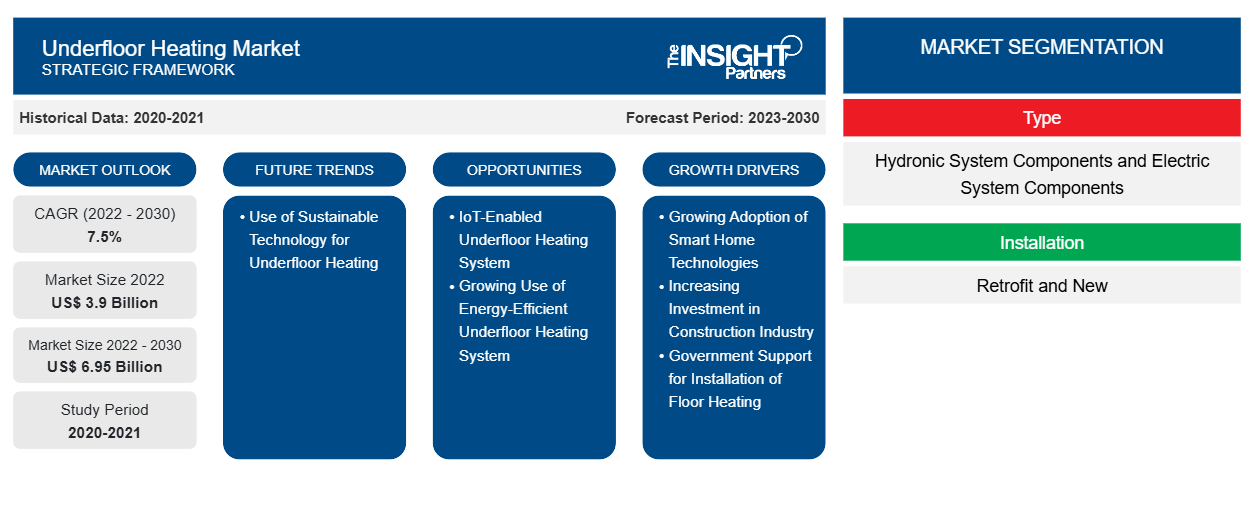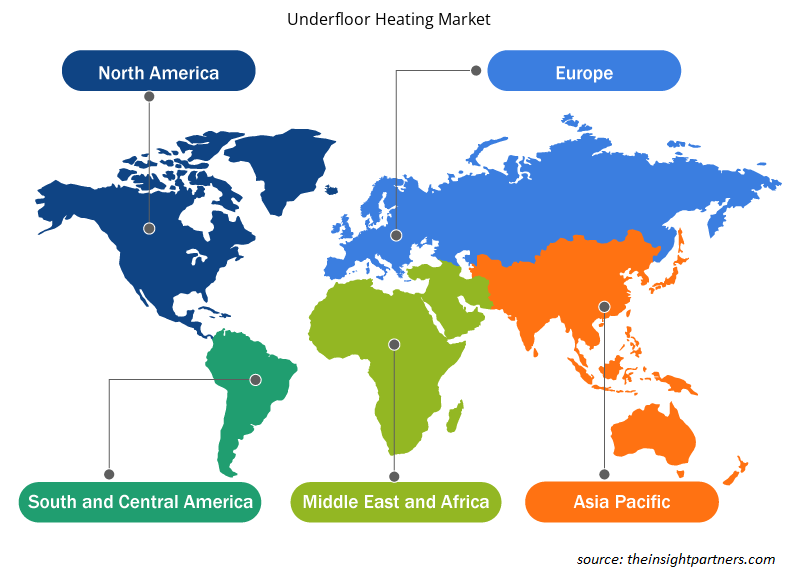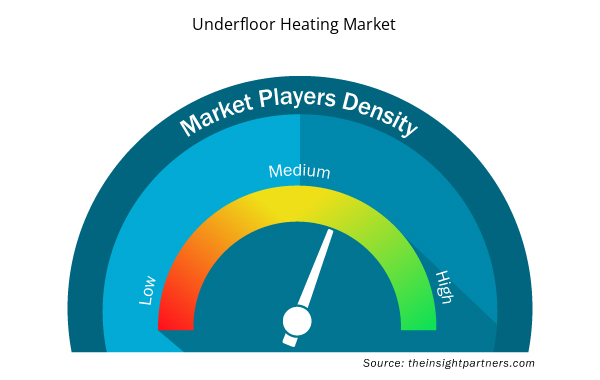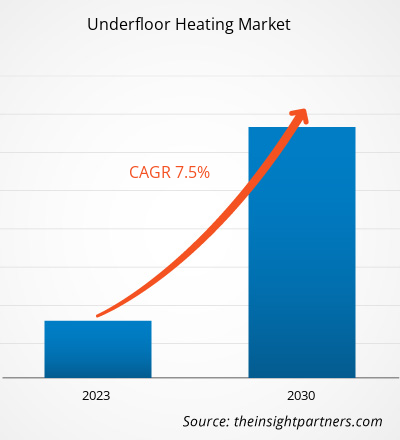[Research Report] The underfloor heating market size is valued at US$ 3.90 billion in 2022 and is expected to reach US$ 6.95 billion by 2030; it is estimated to record a CAGR of 7.5% from 2022 to 2030.
Analyst Perspective:
Underfloor heating is a technique for heating interior spaces that involves placing a heating system beneath the floor surface. This technology produces heat that rises from the floor and warms the room, resulting in a comfortable and even heat distribution. It is a viable alternative to standard heating methods such as radiators. These systems in the underfloor heating market are being majorly used in regions with harsh winters and also in the hospitality industries to provide luxurious living.
Underfloor Heating Market Overview:
An systems in underfloor heating market is installed beneath the floor to provide warmth in indoor spaces. A comfortable and uniform distribution of heat is produced by this technique, as heat rises from the floor to warm the space. Underfloor heating systems have plenty of benefits for homes and offices. It is very comfortable when one walks barefoot on the floor, and it frees up room space since there is no radiator around to take up wall space. For households with renewable heating sources, having underfloor heating systems makes switching to more environmentally friendly homes easier. Underfloor heating works by distributing warm water at a lower temperature through a circuit of pipes below the finished floor.
The adoption of systems in underfloor heating market is increasing in regions where the adoption of smart home technologies and investment in the construction industry is growing. Home automation technology helps to control underfloor heating systems, flow of water or electricity, and others conveniently and easily through voice commands or smartphones. Further, fast development in the building sector and the popularity of the luxury lifestyle have fueled the industry's expansion. Underfloor heating transforms homes and commercial infrastructures into luxurious and sophisticated infrastructure by providing comfort and warmth during the colder months. Further, the advancement of technologies, such as integrating IoT with systems in the underfloor heating market, is anticipated to become a trend during the forecast period. IoT allows consumers to operate and monitor their underfloor heating systems remotely via smartphones, tablets, or other devices. This enables easy access to temperature controls, scheduling, and real-time energy usage monitoring. Sensors and smart thermostats collect real-time temperature, humidity, and occupancy data that can be used with IoT integration.
Customize This Report To Suit Your Requirement
You will get customization on any report - free of charge - including parts of this report, or country-level analysis, Excel Data pack, as well as avail great offers and discounts for start-ups & universities
Underfloor Heating Market: Strategic Insights

- Get Top Key Market Trends of this report.This FREE sample will include data analysis, ranging from market trends to estimates and forecasts.
Customize This Report To Suit Your Requirement
You will get customization on any report - free of charge - including parts of this report, or country-level analysis, Excel Data pack, as well as avail great offers and discounts for start-ups & universities
Underfloor Heating Market: Strategic Insights

- Get Top Key Market Trends of this report.This FREE sample will include data analysis, ranging from market trends to estimates and forecasts.
Underfloor Heating Market Driver:
Government Support for Installation of Floor Heating Drives Underfloor Heating Market Growth
In response to the 10-point plan for a green industrial revolution, the UK government is focusing on energy efficiency. As part of the government's goal to "build back better" following the COVID-19 pandemic, the 10-point plan outlines US$ 12.61 billion of funding. The majority of this funding will be allocated to UK infrastructure projects. However, among those 10 points, plan a significant investment in making homes more energy efficient, the UK is moving away from fossil fuel boilers and stepping toward low-carbon heating sources such as hydrogen and heat pumps. For this, the UK government is emphasizing the policy to improve the energy efficiency of ~2.8 million homes, with 600,000 heat pumps being installed every year by 2028. The government is also encouraging homeowners to consider upgrading their heat emitters to a more efficient option, such as underfloor heating, as it is ~30% more efficient than radiators, especially when connected with heat pumps and other such low-carbon systems.
For instance, in Thiksey—a small, cold village in Leh—the extremely cold temperature has led people to cut down trees in large amounts to obtain wood for burning in cold winters. Electricity generation through solar panels is well suited in summers, but during winters, the absence of sunlight hampers the production of solar power. A new sustainable technology solution called Nilaya housing is projected to bring some comfort from the cold without worries of incurring high energy loads and costs of heating during the cruel winter months when the temperature hits the mark of -30 degrees Celsius in winter. The technology was developed by SMEF's Brick School of Architecture and Pimpri Chinchwad College of Engineering. The underfloor heating systems currently utilize electricity to heat the water at frequent intervals to keep the indoor environment warmed up. The developed technology by SMEFs for the underfloor heating process entails supplying generated greywater to the boiler from an external source. This water is then boiled inside the boiler using biogas as an environmentally friendly fuel. The water is heated to a maximum of 60 degrees before being transmitted to the pipes that are put beneath the floor in the areas. The hot water pipes become heated and emit heat upwards. Thus, such government initiatives emphasize low-carbon heating sources and the development of solutions in the underfloor heating market, based on greywater, driving the growth of the underfloor heating market.
Underfloor Heating Market Segmental Analysis:
Based on type, the underfloor heating market is segmented into hydronic system components and electric system components. Solutions in the underfloor heating market have emerged as a game-changer, providing unparalleled comfort and energy efficiency. One crucial aspect that ensures the smooth functioning of solutions in the underfloor heating market is the hydronic system component. These components play a pivotal role in delivering optimal performance and maintaining a cozy atmosphere in homes, offices, and various commercial spaces. Hydronic system components play a crucial role in the underfloor heating market, providing efficient, reliable, and customizable heating solutions. With advancements in technology, these components have become increasingly sophisticated, offering enhanced control, energy efficiency, and ease of installation. These systems are more efficient to use when applicable for large spaces. Though the initial cost of installation may be more, the running costs for hydronic systems are economical when installed for the long term. Key components of the hydronic system include:
- Boiler: The heart of any hydronic system in the underfloor heating market is the boiler. This device is responsible for heating the water that circulates through the system.
- Pump: Pumping the heated water throughout the underfloor heating system is the task performed by the circulation pump.
- Manifold: The manifold acts as the central distribution point for the heated water. It receives hot water from the boiler and distributes it to individual zones or rooms.
- Thermostats: Temperature control is a crucial aspect of underfloor heating systems. Thermostats regulate the heat output and ensure that the desired temperature is achieved and maintained.
- Pipes and Manifolds: The systems in the underfloor heating market rely on a network of pipes and manifolds to distribute the heated water evenly across the floor.
- Heat Exchanges: In larger underfloor heating systems, heat exchangers are employed to transfer heat from the primary heat source, such as a boiler, to the secondary water loop that circulates through the underfloor pipes.
The segment is further categorized into dry hydronic heating and wet hydronic heating.
Underfloor Heating Market Regional Analysis:
The Europe underfloor heating market was valued at US$ 1.56 billion in 2022 and is projected to reach US$ 2.91 billion in 2030; it is expected to grow at a CAGR of 8.1% during 2022–2030. Homes warmed with underfloor heating are extra comfortable and up to 40% more efficient than those using conventional central heating systems. Underfloor heaters offer a low-carbon heating solution and use radiant heat technology to warm people in a space with infrared energy rather than just warming the air. Thus, underfloor heaters are prevalent in Europe. Several players in Europe are providing underfloor heating. For instance, Warmup underfloor heating products have been installed across the world in over 2.5 million homes and are trusted for their high-quality design. Home heating businesses and industry are responsible for a third of the UK's greenhouse gas emissions. The majority (85%) of homes in the UK are heated by natural gas, followed by oil, coal, and LPG—all nonrenewable fossil fuels. With the Net Zero Emissions Law, the UK government is directing to bring all greenhouse gas emissions to be net zero by 2050, due to which traditional gas and oil heating systems are being gradually phased out. Thus, the UK government is investing heavily in supporting low-carbon electricity, such as renewable source-driven heating systems—including infrared central heating— such renewables-based heating solutions will benefit in the long run by proving environment-friendly and energy efficient.
Underfloor Heating Market Key Player Analysis:
Danfoss, Emerson Electric Co., nVent, Uponor Corporation, REHAU Ltd., Resideo Technologies Inc., Watts, Schneider Electric, Robert Bosch GmbH, and Daikin are among the key players operating in the Underfloor Heating market.
Underfloor Heating Market Regional Insights
Underfloor Heating Market Regional Insights
The regional trends and factors influencing the Underfloor Heating Market throughout the forecast period have been thoroughly explained by the analysts at Insight Partners. This section also discusses Underfloor Heating Market segments and geography across North America, Europe, Asia Pacific, Middle East and Africa, and South and Central America.

- Get the Regional Specific Data for Underfloor Heating Market
Underfloor Heating Market Report Scope
| Report Attribute | Details |
|---|---|
| Market size in 2022 | US$ 3.9 Billion |
| Market Size by 2030 | US$ 6.95 Billion |
| Global CAGR (2022 - 2030) | 7.5% |
| Historical Data | 2020-2021 |
| Forecast period | 2023-2030 |
| Segments Covered |
By Type
|
| Regions and Countries Covered | North America
|
| Market leaders and key company profiles |
Underfloor Heating Market Players Density: Understanding Its Impact on Business Dynamics
The Underfloor Heating Market market is growing rapidly, driven by increasing end-user demand due to factors such as evolving consumer preferences, technological advancements, and greater awareness of the product's benefits. As demand rises, businesses are expanding their offerings, innovating to meet consumer needs, and capitalizing on emerging trends, which further fuels market growth.
Market players density refers to the distribution of firms or companies operating within a particular market or industry. It indicates how many competitors (market players) are present in a given market space relative to its size or total market value.
Major Companies operating in the Underfloor Heating Market are:
- Danfoss AS
- Emerson Electric Co
- nVent Electric Plc
- Watts Water Technologies Inc
- Robert Bosch GmbH
Disclaimer: The companies listed above are not ranked in any particular order.

- Get the Underfloor Heating Market top key players overview
Recent Developments:
Inorganic and organic strategies such as mergers and acquisitions are highly adopted by companies in the Underfloor Heating market. A few recent key underfloor heating market developments are listed below:
- In December 2023, Daikin Europe N.V. unveiled the Nepura range, a new line of residential air-to-air heat pumps that has been available in Europe since November 2023. This product range aims to address the need for a dependable heating solution capable of operating in extreme temperatures as low as -30°C while achieving exceptional efficiency ratings of up to A+++ in heating. The introduction of the Nepura range aligns with Daikin's strategic approach to developing and offering products specifically designed to meet the demands of Nordic conditions.
- In August 2023, REHAU, a prominent provider of polymer-based solutions for mechanical and plumbing systems, unveiled a strategic alliance with BDA Manufacturers' Representatives. This collaboration brings together extensive expertise and experience in the mechanical and plumbing sector, enabling both organizations to enhance their support for contractors, engineers, and wholesalers within the region.
- Historical Analysis (2 Years), Base Year, Forecast (7 Years) with CAGR
- PEST and SWOT Analysis
- Market Size Value / Volume - Global, Regional, Country
- Industry and Competitive Landscape
- Excel Dataset


- Aerosol Paints Market
- Truck Refrigeration Market
- Legal Case Management Software Market
- Rugged Servers Market
- Mesotherapy Market
- Foot Orthotic Insoles Market
- Molecular Diagnostics Market
- Public Key Infrastructure Market
- Emergency Department Information System (EDIS) Market
- Oxy-fuel Combustion Technology Market

Report Coverage
Revenue forecast, Company Analysis, Industry landscape, Growth factors, and Trends

Segment Covered
Type, Installation, and Application

Regional Scope
North America, Europe, Asia Pacific, Middle East & Africa, South & Central America

Country Scope
This text is related
to country scope.
Frequently Asked Questions
Growing adoption of smart home technologies and increasing investment in construction industry are driving factors of underfloor heating market.
The underfloor heating market was estimated to be valued at US$ 3.90 billion in 2022 and is projected to reach US$ 6.95 million by 2030; it is expected to grow at a CAGR of 7.5% during the forecast period.
The increasing use of sustainable technology for underfloor heating is expected to drive the growth of the underfloor heating market in the coming years.
The key players holding majority shares in the underfloor heating market include Danfoss, Emerson Electric Co., Resideo Technologies Inc., Daikin, and Watts.
The hydronic system components segment led the underfloor heating market with a significant share in 2022 and electric system component is expected to grow with the highest CAGR.
The underfloor heating market are expected to reach US$ 6.95 billion by 2030.
Europe is anticipated to grow with the highest CAGR over the forecast period.
Trends and growth analysis reports related to Electronics and Semiconductor : READ MORE..
The List of Companies - Underfloor Heating Market
- Danfoss AS
- Emerson Electric Co
- nVent Electric Plc
- Watts Water Technologies Inc
- Robert Bosch GmbH
- Resideo Technologies Inc
- Uponor Corp
- REHAU Ltd
- Daikin Europe NV
- Schneider Electric SE

 Get Free Sample For
Get Free Sample For